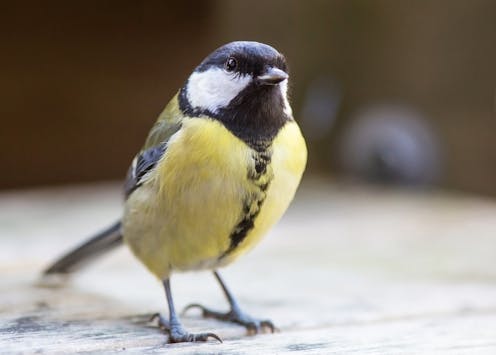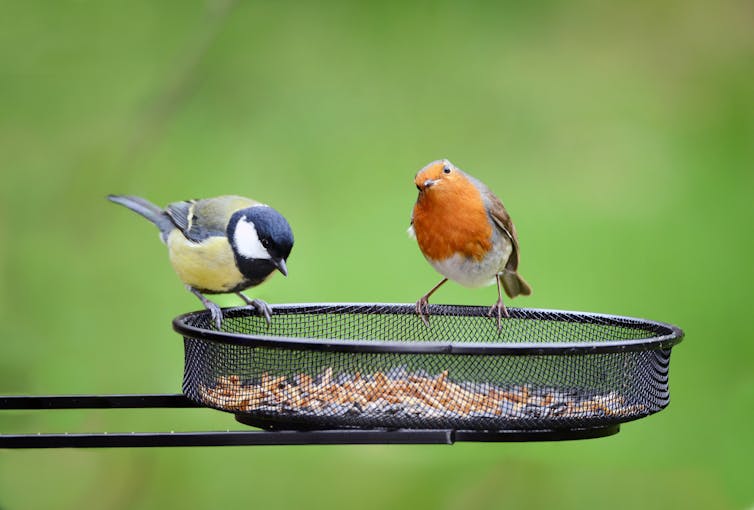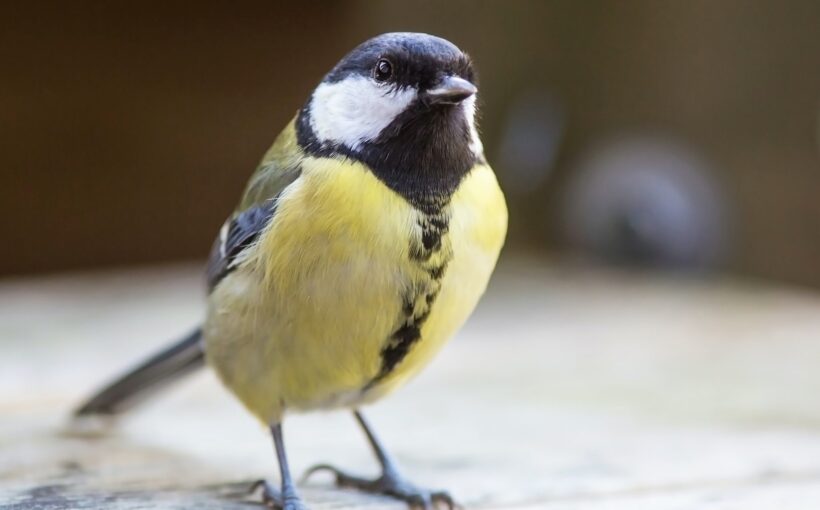
Every day, throughout the world, people put huge quantities of food out at feeding stations for birds and other wild animals.
Although we know that connecting with nature benefits human health and wellbeing, scientists still know relatively little about the consequences of providing food for wildlife. My team’s most recent research, however, has found that feeding garden birds in wintertime seems to make them more resilient to infection.
Winter can be tough for small birds. During cold winter nights, small birds reduce their body temperature by several degrees. While this would be lethal for a human, it saves lots of energy, helping birds to survive particularly cold nights. However, reducing body temperature is risky, and hypothermic birds are slow to wake and respond to a predator.
A reliable food supply at bird feeders can help small birds avoid starvation and survive the harsh winter. Our previous research showed that birds with access to feeders do not need to reduce their night-time body temperature as much as birds that did not have access to feeders. The extra energy birds get from human-provided food means they don’t have to take the risk of becoming severely hypothermic.
Supplementary feeding is controversial since it can also negatively affect wildlife. Birds congregate at feeders, often in large numbers, coming into close contact with one another. Some studies suggest bird feeders have contributed to the spread of infectious diseases such as trichomonosis, which caused huge greenfinch mortalities in the UK in the mid-2000s.
Some people are also concerned that bird feeders may discourage birds from learning to forage for themselves. However, research suggests that supplementary food makes up only a small portion of birds’ diets, and that birds do not become dependent on human-provided food.

We were curious about whether the frequent use of feeders could boost birds’ immune systems, making them better equipped to fight an infection.
Vaccination readies our bodies to tackle a disease by delivering a small dose of a virus or bacterium. Similarly, regular exposure to low doses of pathogens at feeding stations – as a result of infected birds depositing pathogens on to feeders – could better prepare birds to fight an infection.
So, we investigated whether supplementary feeding could make great tits more tolerant to an infection. In a forest in southern Sweden in October 2022, we set up bird feeders that were routinely visited by large numbers of great tits along with lower numbers of blue tits, chaffinches and crested tits. These bird feeders were refilled every few days to ensure a constant supply of peanuts and sunflower seeds throughout the winter.
In late winter, after birds had been visiting bird feeders for several months, we captured great tits at sunset and gave them a “fake infection” – injecting them with a small amount of material from the cell wall of a bacterium. This triggered the great tits’ immune system to think it was being attacked by an invading pathogen, without introducing any of the harmful components of the bacterium.
At the same time, we simulated infection in great tits from another part of the forest, where there had been no access to feeding stations during the winter.
Supplementary-fed birds are more tolerant
One of the first responses of the body to fight off an infection is to raise body temperature and develop a fever. While the “infected” great tits slept, we measured their body temperature throughout the night. We compared the fever responses of great tits that had visited bird feeders throughout the winter with those of great tits that had not visited feeding stations.
We found the great tits that had been using feeders did not increase their body temperature as much as the great tits that didn’t have access to feeding stations. Although fever is important in helping the body fight infection, raising the body’s temperature requires a large investment of energy. Fever and associated inflammation also cause some damage to the body. The best immune response is a careful balance of mounting defences strong enough to tackle the invading pathogen while minimising damage to the body.
So, the supplementary-fed birds seemed to adequately fight the “infection” without using up their precious winter energy supply.
The effects of bird feeding are complex
While we found that the use of feeding stations made great tits more tolerant to an infection, this could also enable infected great tits to stay active, spreading infection between birds.
On the other hand, the greater risk of disease transmission at feeders may be countered by the stronger immune systems these birds could develop due to better nutrition from the food provided by people in parks and gardens.
You can reduce the risk of disease by keeping feeding stations clean. Follow wildlife charities’ guidelines of how to set up a feeding station and what food to put out – and what food to avoid. Great tits are a common visitor to gardens in Europe, so there’s a good chance a bird feeder could attract these colourful birds to your home.
![]()
The research was funded by the Swedish Research Council (Vetenskapsrådet) and Stiftelsen Lunds Djurskyddsfond.



